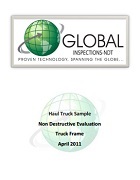Global Inspections - NDT Inc.
ACFM

Alternating Current Field Measurement (ACFM) is particularly suited for the detection and sizing of fatigue cracks on various surfaces. There are excellent opportunities for the ACFM method on mining equipment such as Haul Trucks and Shovels especially for the detection of structural cracks. Haul Truck frames are an excellent application for ACFM. The ability to find and size cracks accurately before the prescribed Preventative Maintenance schedule, saves in numerous lost time hours. Components on Shovels such as side rails, ring gears, dipper sticks, saddle blocks, gantry components and booms are just a few of the areas where the ACFM will work perfectly.
APPLICATIONS FOR ACFM
• Bridges, Cranes, Towers
MULTIPLE APPLICATIONS IN SURFACE BREAKING CRACK DETECTION
We offer comprehensive Non-Destructive testing services in conjunction with our partners at Canadian Rope Access Specialist Inc. who specialize in difficult access assignments, at height, high angle or in confined spaces. Our highly qualified technicians can go where the others can not, providing industry with a comprehensive NDT inspection solution for complicated access areas.
The combination of rope access and the ACFM technique can be adapted to inspect large steel structures such as bridges, cranes and towers with great economic benefits. The ACFM technique is taking its place in the inspection world as a technique which can reliably detect and size surface defects with additional economic and time saving benefits.
APPLICATIONS FOR ACFM
• Bridges, Cranes, Towers
• Mobile Mining Equipment
• Process plant and refinery applications – ability to use in a wet environment
• Oil and Gas – particular for thread inspection on drill pipe in the drilling industry
• Power Generation – both Nuclear and non-nuclear
• Inspections through coatings
• Railways
• Heavy Engineering
• Theme Park rides
• Ship Huls
• Pedestrian and roadway brides
• Underwater weld inspections for offshore platforms
BENEFITS OF ACFM
• Works equally well on parent material or welds, ferrous or non-ferrous metals.
• Inspections include hot surfaces, underwater, or in bright environments.
• Provides both depth and length information. Defects up to 25mm (1") in depth. Can be sized accurately.
• Rapid scanning using a hand-held probe.
• Reliable crack detection and sizing (length and depth).
• Dramatically reduces most cleaning requirements with no need to clean to bare metal.
• Capable of inspection through thin metallic coatings, or through non-conducting coatings up to 10mm thick.
• Full data storage for back-up, off-line view and audit purposes.
• Intelligent probes to simplify operation.
• Operating Temperature: -20°C to +40°C -4°F to +104°F
Source: http://www.global-ndt.ca/crack-detection/acfm.html

|